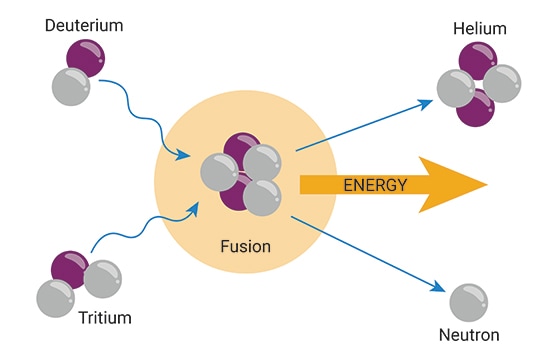Key Takeaways
- Theoretically, nuclear fusion has the potential to generate clean energy while mitigating the effects of global warming
- Lawrence Livermore National Laboratory (LLNL) in California conducted the first nuclear fusion experiment to achieving a net energy gain in the context of the National Ignition Facility (NIF) project
- Agilent’s vacuum division provided LLNL with trusted answers and the best possible technology (Agilent 80 L/s turbomolecular pumps) to support their required experimental conditions, which led to their success

On 13 December 2022, the U.S. Secretary of Energy announced a major scientific breakthrough from a Department of Energy (DOE) National Laboratory: Lawrence Livermore National Laboratory (LLNL) in California has carried out the first nuclear fusion experiment to achieving a net energy gain in the context of the National Ignition Facility (NIF) project.

What is nuclear fusion?
Nuclear fusion is a reaction that powers our main source of light and energy: the sun, as well as other stars. In the reaction, two (or more) atomic nuclei—encompassing protons and neutrons—fuse to form larger nuclei while releasing energy. This energy release occurs because the total mass of the resulting nuclei is less than the mass of the original nuclei that was fused. The leftover mass becomes energy that can be used to run a turbine-electrical power generator.
For example, when deuterium and tritium (both isotopes of hydrogen) fuse, a helium nucleus forms, releasing an excess neutron and, more importantly, energy that can be stored (see Figure 1).

Figure 1. A schematic diagram of nuclear fusion.
Making a star on Earth to create energy
Research scientists are attempting to recreate nuclear fusion—the reaction in which stars of our universe are generated—on Earth because the reaction can create enormous amounts of energy.
For nuclear fusion to occur, stellar-like temperatures (i.e., 100 million+ degrees) must be achieved. This process forces the positively charged nuclei to form plasma within a contained vector, overcome their repulsion by moving independently at speeds of around 1,000 km/s, and fuse together.1
Theoretically, if the energy generated from lab-controlled nuclear fusion could be harnessed and effectively stored on a global scale, this technology could transform how we fuel our homes, businesses, and vehicle transportation. The reaction is so efficient that 1 kg of fusion fuel could provide the same amount of energy as 10 million kg of fossil fuel.2
Urgent demand for clean energy
Since the 19th century, Earth’s temperature has increased by approximately 1.1 °C. The amount of carbon dioxide has risen by 50% because greenhouse gases have been released from fossil fuels burnt for energy.3
Average temperature increases should not exceed 1.5 °C by the start of the 22nd century, scientists are warning.4 However, there is an urgent demand for clean energy implementation on a global scale, as a UN report from October 2022 predicts Earth’s temperature will rise by at least 2.4 °C by 2100.4
An emerging solution for clean energy

Research scientists in this field highlight the fact that nuclear fusion may be the solution for generating clean energy while mitigating the effects of global warming. The process does not rely on using energy sourced from fossil fuels, and does not produce greenhouse gas pollutants or long-lived radioactive waste. Fusion reactor materials can also be recycled or re-used within 100 years.
In essence, nuclear fusion provides a vision toward clean and low-price energy that is within our grasp, and which one day may be able to support our daily lives, economies, and technological evolutions.
A milestone achievement at LLNL
On 5 December 2022, the LLNL team at its National Ignition Facility (NIF) conducted a nuclear fusion experiment that resulted in a milestone achievement to date: energy breakeven—meaning that the experiment produced more energy than required to initiate the process.
The breakthrough represents a historic moment; it comes at a much-needed time, as the world faces high and unstable energy prices and unprecedented effects of global warming due to continual, global fossil-fueled energy use.
NIF development and testing spans over 50 years, and the facility leads the international laser fusion scientific community where other experiments operate, such as the Japanese FIREX and SG-III in China.
The ground-breaking experiment
In the most recent experiment, a single laser was split into 48 optical channels, then amplified and split again into 4 channels, creating 192 beams.

The 192 lasers heated and compressed a deuterium-tritium target to create temperatures like those in the center of the sun. The outside of the sphere vaporized, becoming plasma that imploded in a few fractions of a second and reached velocities up to 400 km/s (250 mi/s). The subsequent ‘crunch’ produced such high density in the compressed ‘fuel’ that nuclear fusion occurred.
The net energy gain occurs when the power emitted by the fusion reaction exceeds the energy provided to the target. In this case, the researchers used 2 MJ of energy to generate 3 MJ.
Agilent’s contribution

Figure 2. An Agilent TwisTorr 84 FS turbo pump.
Agilent worked with the (PEPC) Plasma Electrode Pockels Cell group at LLNL, where the Large Aperture Plasma Electrode Pockels Cell technology, a special optical switch, was originally developed and is one of the key technologies for reducing the required size of the NIF.
The optical switch prevents each laser from exiting the main amplifier and allows 4 passes of the 192 beams, further amplifying the energy and conditioning of each beam through special optical components before they are released again on a path to the target chamber. Clean, stable vacuum is an essential condition for this section of the NIF laser experiment.
"We partnered with LLNL to generate and maintain the required experimental conditions. The key was our turbomolecular pumps. To achieve its vacuum, the PEPC group used 48 Agilent 80 L/s turbomolecular pumps to guarantee proper operation and perfect pressure levels,” commented Ed Gordon, account manager at Agilent Technologies.
Advancing the research field
Now that LLNL’s research team has successfully demonstrated net-energy gain from a nuclear fusion experiment, there are still some technical challenges to overcome, such as:
- Replicating the experiment—if the conditions of the reaction are not favorable, it halts
- Further optimization of all reaction conditions while ensuring that all components are robust enough to withstand the extreme environment necessary for nuclear fusion to occur
- Yielding and extracting an even higher energy output from the nuclear fusion reaction
The next R&D phase at LLNL—as well as associated research labs—will most likely involve replication and method development with the aim of achieving higher energy gains, making advancements toward longer-term commercial viability. When it comes to vacuum technology support, Agilent products and expertise will continue to play an important role in advancing this research field.
The unsung vacuum pump hero
“We at Agilent are very proud that our vacuum pumps have been instrumental in the success of the most astonishing experiments of this millennium: discovering the Higgs boson, detecting gravitational waves, and now controlled nuclear fusion,” said Mauro Audi, business development manager for academia, government, and research.
In many ways, vacuum pumps are the unsung heroes of the most fascinating and innovative research experiments that have recently occurred, and in which Agilent is honored to have played a role.